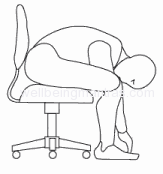The Low Back and Core: The Importance of Strength and Stability Exercises
Do you know what makes up your "core"? Is it just your stomach muscles? No! It's a collection of many muscles that make up what is known as your "core"; these include muscles that are located around the lumbar region of your spine, also known as your low back. The muscles work together to give support and stability to the rest of your body. All of the muscles of your core are located in the abdomen, low back, hips and pelvis.
Doing exercises on a regular basis to stretch and strengthen these “core” muscles can help manage and maintain the lumbar spine and overall body’s health. Not only will doing these exercises help prevent injury and/or re-injury, but learning the correct mechanics to perform them will increase your odds of injury prevention even more. Contracting your core muscles while performing these exercises is very important to activate and strengthen them in the process.
Muscle imbalances that occur in one area of the body will cause your body to compensate to make up for the non-functioning area(s). The compensating muscles are forced to function in ways they were not meant to be, thus leading to pain and discomfort in the future.
What are the benefits to doing strength and stability exercises?
Decrease in pain/discomfort - with potential for relief entirely.
Ability to perform activities of daily living more efficiently, and/or increase your ability/endurance to do daily activities you were unable to perform previously.
Prevention and/or recovery from soft tissue injury - i.e. sprain/strain, tendonitis, etc…
Decrease risk of sustaining an injury due to everyday stressors at work and in your life.
Pictured below are a few examples of stretches and strengthening exercises you can incorporate into your daily routine to help your low back and core. By performing these on a regular basis, it can help keep your muscle lose, increase your flexibility and help alleviate and/or maintain your low back discomfort. You can perform the stretches daily and as many times throughout the day as you would like. Make sure you are only going until a good stretch is felt. If at any point there is pain experienced, stop, and consult with your healthcare provider to make sure you are performing the stretches and exercises properly.
Examples of STRETCHES to incorporate into your daily routine:
A)

Relax completely into the position and hold for 20-30 seconds to stretch the muscles fully. You can perform this stretch at your desk throughout the day or on your breaks.
B)

These can be done in the morning before you get out of bed, or at night when you lay down. With knees bent, hold each position for 20-30 seconds, making sure shoulders stay in touch with the floor/bed at all times.
Examples of STRENGTHENING EXERCISES to incorporate into your daily routine:
A)

Make sure to "draw your belly button to your spine" to activate your core muscles. Keep your shoulder in line with your elbow at 90 degrees. If you find yourself in pain, or unable to hold the position, you can modify this side plank and go down onto your knees to perform.
B)

Hold position for 3-5 seconds, and then relax. Start with 2 sets and 6-10 repetitions per side, and increase them as you build endurance. Make sure to “draw your belly button to your spine” to activate those core muscles for the entire exercise. To increase the difficulty, you can add a resistance band. Adding stretching and strengthening exercises into your routine doesn't have to be a difficult affair, nor does it need to involve lots of equipment or a gym membership. If you have questions on how to get started, even with just a few basic moves, don't hesitate to ask us!



















